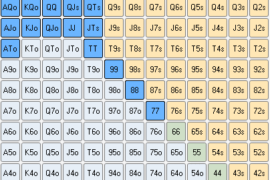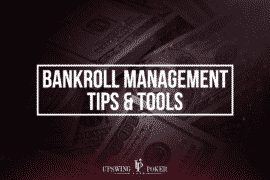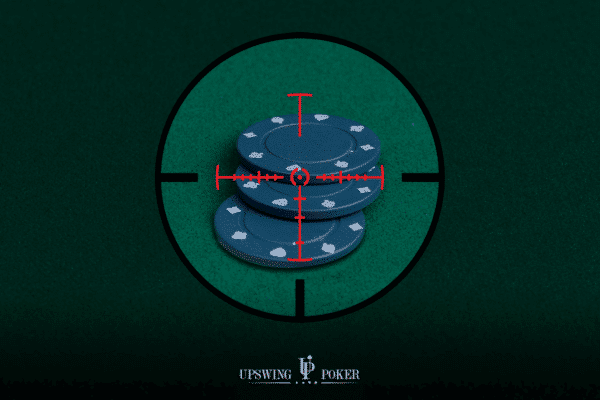
Limps in Poker: The Ultimate Guide to Crushing Open Limpers
Think of limpers as your most valuable customers.
Every time you see someone limp into the pot, you’re being handed an opportunity — often to win their entire stack, or at least a big chunk of it, in short order.
You’re about to learn how to absolutely destroy these players. Here’s what you will find in this article (click a section to skip to it):
- Why Friends Don’t Let Friends Open-Limp
- Preflop Strategy vs Limpers
- Postflop Strategy vs Limpers
- 7 Tips That Have Helped Me Win Countless Stacks from Limpers
Without further ado, let’s dive in!
This article has been updated (originally published July 20th, 2018).
Why Friends Don’t Let Friends Open-Limp
Never be the first player to limp into the pot. I repeat, never be the first player to limp into the pot.
Open-limping (just calling the price of the big blind as the first player in the pot) is basically never a good strategy. This is a topic we have discussed many, many times, but it’s worth revisiting.
Pro note: There are very few exceptions to this “don’t open limp” rule. In short, limping is only optimal in a few scenarios such as when it folds to the blinds or when there’s a big ante.
Open-limping is a weak and passive play that leaves you few ways to win the pot. This is not to be confused with limping behind other limpers, which has its place, and can be profitable.
When you raise preflop, there are a few ways for you to win the pot:
- All of the other players at the table fold.
- You win postflop with a c-bet or barrel against one or two opponents.
- Your hand hits the board and you are able to win at showdown.
Not only can you not win the pot preflop by limping, the play also makes it more challenging to steal the pot postflop. This is because there will likely be several other players in the pot.
Limping also prevents you from representing a strong hand on certain board textures. You aren’t telling a very credible story about having a big hand on that A-J-T flop if you limped preflop, and then go H-A-M postflop.
Your most likely avenue to win the pot when you limp is to hit your hand and win at showdown. Raising preflop also serves another purpose. It forces players behind to make a more difficult decision about their hand.
Preflop Strategy vs Limpers
Not all limpers are created equal. This section of the guide will go into specifics on why that is.
First, it will cover the two approaches you can use when facing a limper. Then it will demonstrate a baseline strategy for playing against a limper when you have no reads on them.
The Two Approaches to Countering Limps
The optimal strategy when facing a limper depends on a number of variables:
- The skill level and tendencies of the limper
- The aggressiveness of the players at your table
- Your stack depth
That said, there are two major ways to approach open limps.
1. Play tighter
Playing tighter against limpers makes sense from a theoretical perspective.
When someone limps, they’re signaling that they have a hand they consider playable from that position.
Sure, some players will limp random and trashy hands, like 9c 3h, but those are rare these days.
So, now you’re up against a player with at least a semi-reasonable hand, plus the Small Blind and Big Blind. That’s three players to worry about.
There are a few more specific variables to watch out for that should make you take this tighter approach when facing limpers:
- The limper is a competent player with a potentially balanced limping range
- Players behind you are aggressive
- Effective stacks are short
But if the limper is a weak and/or inexperienced player worth targeting, the better approach might be to…
2. Loosen up
Playing looser against limpers can be a good move, but it’s riskier.
When a player frequently open-limps preflop, you can assume they’re weak, passive, and worth targeting with aggression. A player who open-limps regularly is prone to making mistakes—after all, they’ve already made one by limping preflop.
The mistakes they make postflop will allow you to over-realize your equity when you isolate them. Limpers rarely put you in difficult spots postflop, making it easy to win pots you aren’t “supposed” to win.
You should actively look for opportunities to play pots with these passive players. Forcing a limper to call your raises preflop (out of position and with a weak range) is one of the most profitable situations in poker.
That said, a few other factors need to be in your favor to make loose play against limpers truly optimal:
- The open limper is unlikely to limp and then 3-bet.
- Effective stacks are deep, increasing the chance the limper makes a costly postflop mistake.
- The players behind you are tight and unlikely to 3-bet.
When it comes to sizing, aim to find the perfect amount that puts the weakest hands in their range in the toughest possible spot. Of course, that’s essentially the goal of any bet in poker. (We’ll dive deeper into sizing in Tip #1 at the end of this article.)
Don’t squander your opportunities against weak players who limp into pots. Keep isolating them and putting them in difficult spots until they give you a real reason to stop.
Some players will let you hammer them limp after limp without ever pushing back. Sure, they’ll make a hand once in a while—but that shouldn’t faze you.
You’ll already have stolen so many pots from them that you will be paying them with their own money, like Teddy KGB at the end of Rounders.

Baseline Strategy vs Limpers
You won’t always know how a player approaches limping, especially when you first sit down at the table. That’s why it’s important to have a solid baseline strategy for playing against limpers. From there, you can adjust as new information comes in.
This default range assumes you’re facing a competent player who limps with some thought behind it. That’s not to say he’s using a balanced limping strategy (almost nobody is), but he’s at least being selective.
By “limping thoughtfully,” I mean he’s choosing to limp with hands that fall in the gray area: not quite strong enough to raise, but still playable. Think A4 offsuit in late position, K6 suited from mid-late position, or 65 suited from early-mid. You might also see the occasional trap mixed in.
With that in mind, here’s the range I’d use as my starting point. These are the hands I would always raise against a limper if I had no reads and was sitting in early or middle position (you can loosen up from later positions):

Red = Raise, Blue = Fold
You may be thinking that this range is tight, and it is, but let me explain why it’s a great baseline strategy for raising over an unknown limper:
- It’s made up of hands that hit well and can extract value, which is the primary way to profit from a limper.
- There are still players left to act who can 3-bet or cold-call, which makes equity realization more difficult.
- You don’t yet know whether the limper tends to fold, call, or play aggressively postflop — so it’s unclear whether weaker hands will perform well as raises.
Without reliable info on these factors, it’s smart to keep things tight and avoid putting yourself in marginal spots.
You can start adding more hands depending on these factors:
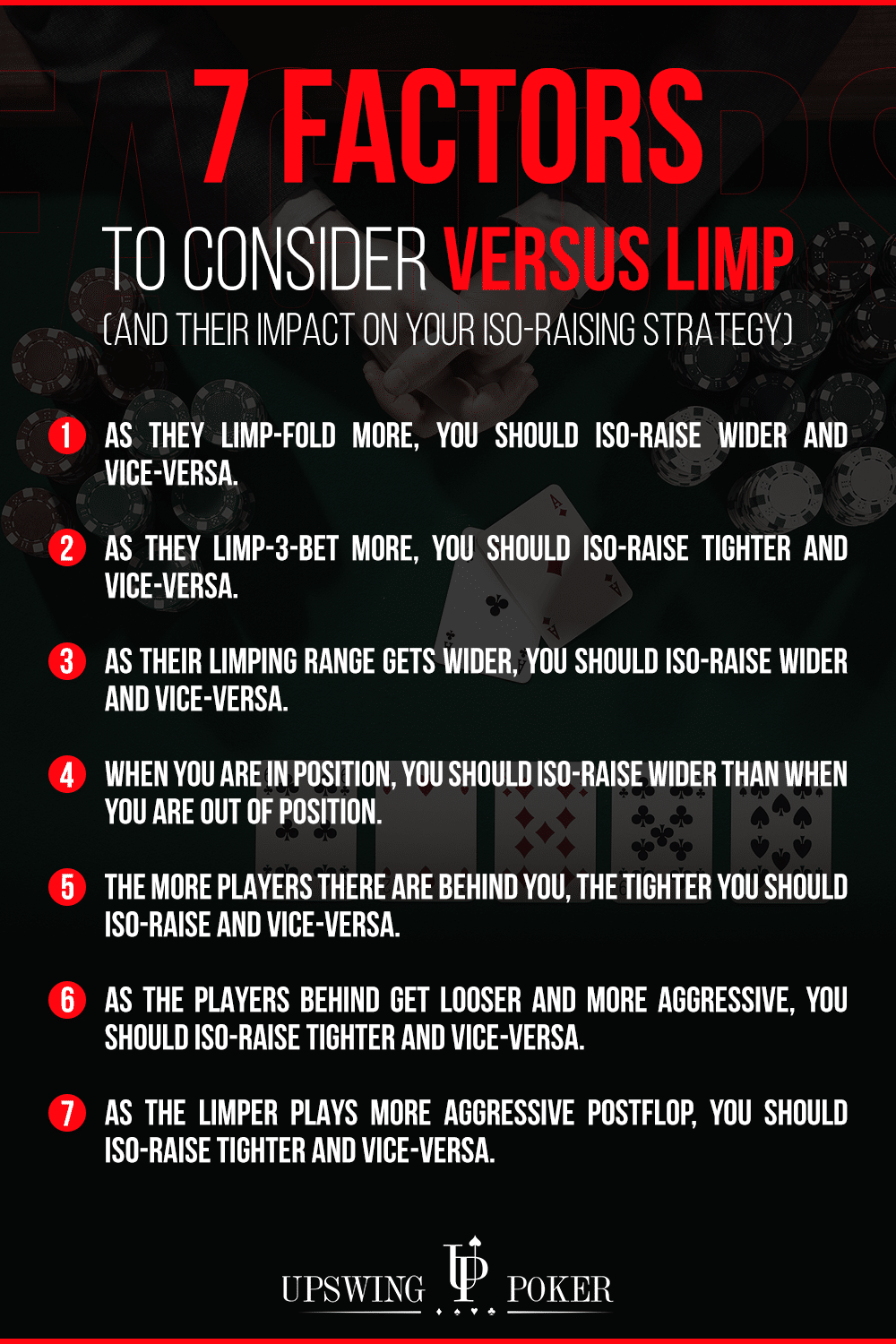
Note that while some of the following tips may suggest tightening up, I don’t recommend removing any hands from the baseline range above. That range represents the tightest you should ever play against a limper.
To wrap up, here’s one more example for your reference: the recommended Button vs. Limp range from the Upswing Lab. This assumes exactly one limper, regardless of their position:

Button vs Limper range recommended in the Upswing Lab.
The looser/weaker the limper is, the more light blue hands you can profitably raise with. Get “Vs Limp” charts for all 8 positions when you join the Upswing Lab.
Postflop Strategy vs Limpers
Now that you have a solid understanding of which hands to raise over a limper, let’s shift to postflop play — specifically, how to approach the flop.
We’ll walk through two example flops that represent common board textures. In both cases, you’ll be on the Button playing against a Hijack limper.
Assume your opponent is a somewhat competent player who limp-calls with a justifiable — though still flawed — range, including hands like:
- Weak to medium strength Ax hands (suited and offsuit)
- Offsuit broadways
- Offsuit connectors (like T9, 98)
- Suited connectors and 1-gappers (like 76s, 75s, 64s)
- Random high card suited hands (K7, Q8, J7, etc.)
Example #1
Online $2/$5. 6-Handed. Effective Stacks $500.
Hero is dealt two cards on the Button
UTG folds. Hijack calls $5. Cutoff folds. Hero raises to $20. 2 folds. Hijack calls.
Flop ($47): 8s 5d 3s
Hijack checks. Hero…
Let’s break your range down into two parts: value bets and potential bluffs.
Value Bets: Against weaker players on low boards, you’ll want to play your value hands in a very straightforward and aggressive way. Widen your value range and fire big bets — anywhere from 66% to 105% pot — followed by frequent double barrels to extract value right away.
If the limper seems unaware (as most are), size your bets based on hand strength. With a very strong hand like QQ, go big — 80% pot or more. But with a more marginal value hand like 77, a smaller size like 66% pot is usually better.
Bluffs: When the limper appears to play fit-or-fold postflop, you should expand your bluffing range beyond just the obvious candidates like gutshots, open-enders, and flush draws.
What kinds of hands should you add? Look for hands with two overcards and little showdown value — think KJ, KT, QT, and similar combos. These hands have six clean outs to top pair and can become value hands on later streets, making them excellent candidates to semi-bluff.
There’s another exploit you can use against unaware limpers, one you should never try against a solid, thinking player: reduce your bluffing bet size. Betting smaller, somewhere in the 50% to 60% pot range, gives you better pot odds and takes advantage of the inelastic calling tendencies common among weaker players.
Even if the limper adjusts correctly by calling more often, you still benefit: their range going into the turn is often weaker than normal, which makes your double barrels more effective.
If the limper seems too sticky, though, tighten up your bluffing range to include only your strongest draws. There’s no point in bluffing someone who can’t be bluffed.
Now let’s look at a different type of flop, one that calls for a slightly different strategy.
Example #2
Online $2/$5. 6-Handed. Effective Stacks $500.
Hero is dealt two cards on the Button
UTG folds. Hijack calls $5. Cutoff folds. Hero raises to $20. 2 folds. Hijack calls.
Flop ($47): As 9d 3c
Hijack checks. Hero…
Value Bets: You can apply the same principle as before: the stronger your hand is in absolute terms, the larger you can bet. Simple and effective.
Bluffs: Bluffing works a bit differently on this type of board. Because there are no overcards that can fall on the turn, betting big becomes less attractive. If your opponent has missed the flop, which will often be the case, it won’t matter whether you bet $15 or $30. He’s likely folding either way, since most of his misses won’t have two overcards to backdoor into something.
This is a sharp contrast to the previous example, where the board texture made it likely your opponent held at least two overcards (or a gutshot or better). On those boards, sizing up can make sense. But here, since so much of your opponent’s range will miss entirely, you can punish that by betting every one of your own misses for a small size, say $15, roughly 30% of the pot.
7 Bonus Tips That Have Helped Me Win Countless Stacks from Limpers
To round out this guide, we will go over seven bonus tips to help you win as much as possible when facing a limp.
To wrap up this guide, here are seven bonus tips that will help you maximize your profits when facing a limper.
Tip #1: Raise to 3bb+1bb per limper when playing online, and 4bb+1bb per limper when playing live
These raise sizes have stood the test of time. They’re large enough to discourage players behind you from cold-calling with poor pot odds, but still small enough for the limper to call with their usual junk, which is exactly what you want.
That said, you should always be ready to adjust in order to maximize value against weak players.
For example, in a live game, if your 5bb raises are getting snap-called by players holding trash, try bumping it up to 6bb, then 7bb, and so on, until you finally get some folds. Once they start folding, dial it back to the previous size.
This simple tweak helps you build bigger pots while maintaining a significant range advantage.
Tip #2: Iso-raise with a slightly tighter range from the blinds
Playing out of position (OOP) is always tougher because you have less control over the betting. That’s why it makes sense to keep your range tighter when you’re OOP — especially when iso-raising.
You’re often facing a loose, unpredictable calling station, which makes bluffing less effective. Instead, you’ll want to iso-raise with hands that can flop strong top pairs or solid draws — hands that don’t mind getting to showdown or barreling for value.
As a rough guideline, stick to the red hands from the Button iso-raising chart when you’re in the blinds.
Remember: When you’re out of position, tighter is better.
Tip #3: When your opponent limp-3-bets, assume they have a strong range
If you’ve played live poker for any length of time, you’ve probably seen players limp with Aces, Kings, or Queens, hoping to spring a trap. This same play happens online, too, and more often than you might think.
When a player limps, it’s usually because they either don’t think their hand is strong enough to raise or they’re slow-playing a premium hand like AQ+, JJ+. Occasionally, you’ll run into a weird bluff, but most of the time, a limp-3-bet signals serious strength. You should adjust your response accordingly.
The hands that perform best against this kind of range are strong suited Broadways, AQ offsuit, and pocket pairs. That said, some players will only limp-3-bet with JJ+, AK. When you spot someone doing this, pay close attention to their stack size.
-
If they’re short, you should only continue with JJ+ and AK.
-
If stacks are deeper (100bb or more), you can justify set-mining with smaller pairs, hoping to stack them when you hit.
Just don’t get sticky. If you miss the set, fold. Bluff-catching against this kind of range is usually a losing proposition.
Tip #4: Value bet thinner, especially on the flop and turn
Recreational players who limp are often calling stations, too. That means they’ll call big bets with weak hands just to chase draws, far more often than a solid player would.
They usually misunderstand pot odds and massively overestimate their implied odds. As a result, they’re happy to call large bets while drawing to straights, flushes, sets, or even random two-pair combos.
This creates a golden opportunity: start going for thinner value than you normally would, especially on the flop and turn. You’ll be surprised how often these players pay off with second-best hands.
Tip #5: Don’t barrel with weak draws
Recreational players tend to be much stickier than solid opponents. That means your bluffs won’t get through as often, and trying to push them off marginal hands can burn money fast.
Instead of firing indiscriminately, be more selective. Focus on bluffing with hands that have solid equity, like strong gutshots, open-enders, flush draws, and combo draws. These hands give you multiple ways to win: either by getting a fold or by improving on later streets.
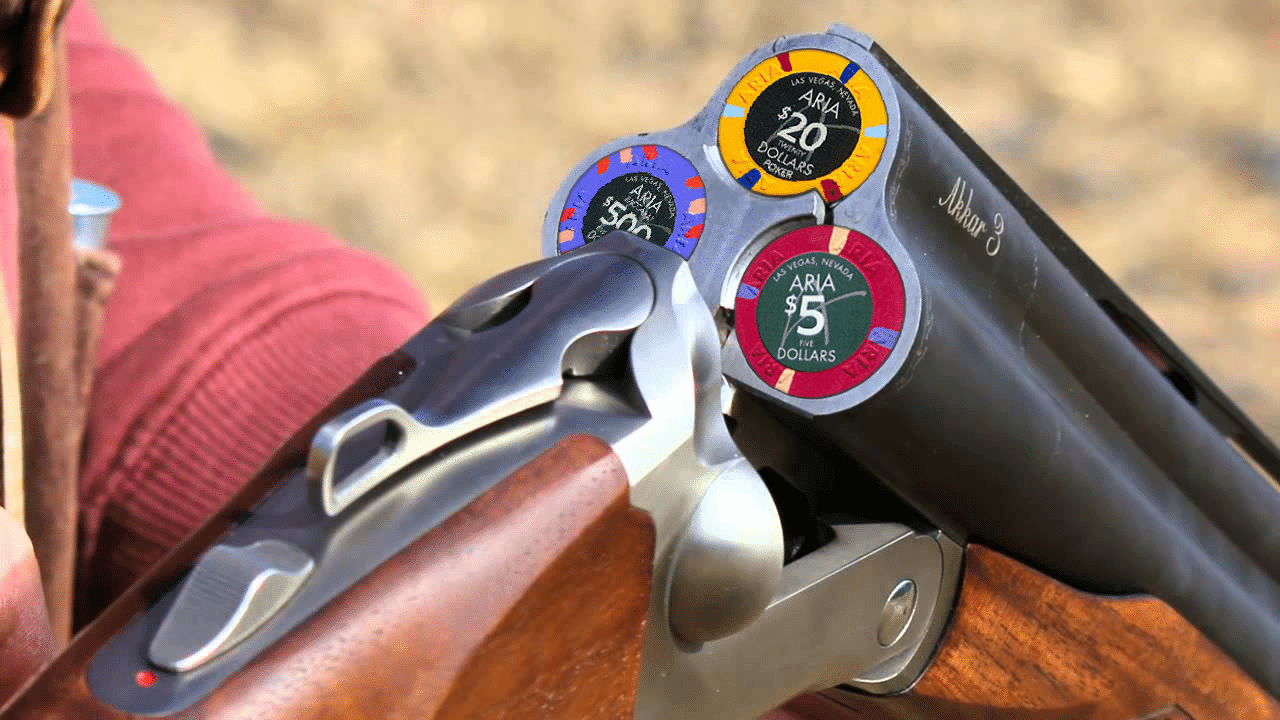
Lean towards using just one of these barrels vs limpers.
This happens because they go to the flop with a wide and weak range, which misses much of the time; while the range they will go to the turn with is a much more pair- or draw-based, and very infrequent includes air type hands.
For this reason you should usually be wary of bluffing on the turn, and instead try a ‘one-and-done’ strategy on the flop. You should, however, make sure you capitalize on the fact that recreational players fold more than they should on scare cards.
Tip #6: Tend to bluff-catch more often on the river
Players who open-limp tend to show up with a wide and sometimes surprising range of hands. That means by the time they reach the river, their range is often much wider than a regular’s — and harder to pin down.
They also love to slow-play. Limpers often enjoy the feeling of trapping, which means they’ll check strong hands more often than regulars do. Put these two traits together, and you’ll find that they may bluff too often on average, simply because their river range includes so many missed hands.
That said, always consider player type. If the limper is passive, they may still not bluff enough, even when their range is full of misses. Against those players, you should lean toward folding unless you have a clear bluff-catcher.
Tip #7: Limp behind with hands that aren’t strong enough to raise and play well multiway
As previously mentioned, limping behind another limper can be a good play.
If you look down at a hand that seems too weak to raise but plays well in multiway pots, consider limping behind.
Related article: The Starting Hands That Make the Most Money in Multiway Pots
For example, suppose a player limps in early position and you look down at 4s 4d on the Button. Raising this hand isn’t a bad move, but depending on how the limper plays, you might be better off limping behind. Same goes for hands like As 6s and 8h 7h.
Wrapping Up
As with any situation in poker, there are plenty of nuances when it comes to playing against limpers.
There’s no universal best line — it depends heavily on the player, the stack sizes, and the dynamics at the table. You’ll need to apply sound logic in each spot, realistically assess how your opponent is likely to respond to different bet sizes, and then determine the most profitable course of action based on that.
Just remember — the highly exploitative advice in this article, especially when it comes to tailoring your bet sizes, is intended for use against weak, unaware players. Against tougher, more balanced opponents, these same strategies can backfire. If they catch on to what you’re doing, you risk getting exploited yourself.
Hopefully you feel more comfortable playing against limpers after reading this article. If you have any questions or feedback please leave a comment section down below!
Want more? Here’s the article I recommend reading next: How to Adjust Your Strategy in Splashy Live Games.
Til’ next time, good luck, grinders!


